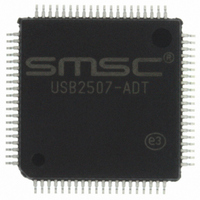USB2507-ADT SMSC, USB2507-ADT Datasheet - Page 15

USB2507-ADT
Manufacturer Part Number
USB2507-ADT
Description
IC HUB 7PORT USB COMPATBL 80TQFP
Manufacturer
SMSC
Type
Integrated USB Compatible 3 Port Hubr
Datasheet
1.USB2507-ADT.pdf
(44 pages)
Specifications of USB2507-ADT
Controller Type
USB Hub
Interface
I²C
Voltage - Supply
3 V ~ 3.6 V
Current - Supply
100mA
Operating Temperature
0°C ~ 70°C
Mounting Type
Surface Mount
Package / Case
80-TQFP, 80-VQFP
Operating Supply Voltage
3.3 V
Maximum Operating Temperature
+ 70 C
Minimum Operating Temperature
0 C
Mounting Style
SMD/SMT
Supply Voltage Range
1.62V To 1.98V, 3V To 3.6V
Digital Ic Case Style
TQFP
No. Of Pins
80
Operating Temperature Range
0°C To +70°C
Data Rate Max
480Mbps
Rohs Compliant
Yes
For Use With
EVB-2507 - BOARD EVALUATION FOR USB2507
Lead Free Status / RoHS Status
Lead free / RoHS Compliant
Other names
638-1032
Available stocks
Company
Part Number
Manufacturer
Quantity
Price
Company:
Part Number:
USB2507-ADT
Manufacturer:
Standard
Quantity:
3 248
Company:
Part Number:
USB2507-ADT
Manufacturer:
MAXIM
Quantity:
43
Company:
Part Number:
USB2507-ADT
Manufacturer:
Microchip Technology
Quantity:
10 000
Part Number:
USB2507-ADT
Manufacturer:
SMSC
Quantity:
20 000
Company:
Part Number:
USB2507-ADT
Manufacturer:
SMSC
Quantity:
12 384
Integrated USB 2.0 Compatible 7-Port Hub
Datasheet
Chapter 5 Functional Block Description
SMSC USB2507
5.1
5.1.1
5.1.1.1
5.1.1.2
5.1.1.3
5.1.1.4
7-Port Hub
SMSC’s USB 2.0 7-Port Hub is fully specification compliant to the Universal Serial Bus Specification
Revision 2.0 April 27,2000 (12/7/2000 and 5/28/2002 Errata). Please reference Chapter 11 (Hub
Specification) for general details regarding Hub operation and functionality.
For performance reasons, the 7-Port Hub provides 1 Transaction Translator (TT) per port (defined as
Multi-TT configuration), divided into 4 non-periodic buffers per TT.
Hub Configuration Options
The SMSC Hub supports a large number of features and must be configured in order to correctly
function when attached to a USB host controller. There are three principal ways to configure the hub:
SMBus, EEPROM, or by internal default settings. In all cases, the configuration method will be
determined by the CFG_SEL1 and CFG_SEL0 pins immediately after RESET_N negation.
Vendor ID
Is a 16-bit value that uniquely identifies the Vendor of the user device (assigned by USB-Interface
Forum). This field is set by the OEM using either the SMBus or EEPROM interface options. When
using the internal default option, SMSC’s VID (see
Product ID
Is a 16-bit value that the Vendor can assign that uniquely identifies this particular product (assigned
by OEM). This field is set by the OEM using either the SMBus or EEPROM interface options. When
using the internal default option, SMSC’s PID designation of (see
Device ID
Is a 16-bit device release number in BCD format (assigned by OEM). This field is set by the OEM
using either the SMBus or EEPROM interface options. When using the internal default option, SMSC’s
DID designation of (see
Self-Powered/Bus-Powered
The Hub is either Self-Powered (draws less than 2mA of upstream bus power) or Bus-Powered
(limited to a 100mA maximum of upstream power prior to being configured by the host controller).
When configured as a Bus-Powered device, the SMSC Hub consumes less than 100mA of current
prior to being configured. After configuration, the Bus-Powered SMSC Hub (along with all associated
hub circuitry, any embedded devices if part of a compound device, and 100mA per externally available
downstream port) must consume no more than 500mA of upstream VBUS current. The current
consumption is system dependent, and the OEM must ensure that the USB 2.0 specifications are not
violated.
When configured as a Self-Powered device, <1mA of upstream VBUS current is consumed and all 7
ports are available, with each port being capable of sourcing 500mA of current.
This field is set by the OEM using either the SMBus or EEPROM interface options. When using the
internal default option, the SELF_PWR pin determines the Self-powered or Bus-powered status.
Please see the description under Dynamic Power for the self/bus power functionality when dynamic
power switching is enabled.
Table
5.1) will be reported.
DATASHEET
15
Table
5.1) will be reported.
Table
5.1) will be reported.
Revision 2.3 (08-27-07)















